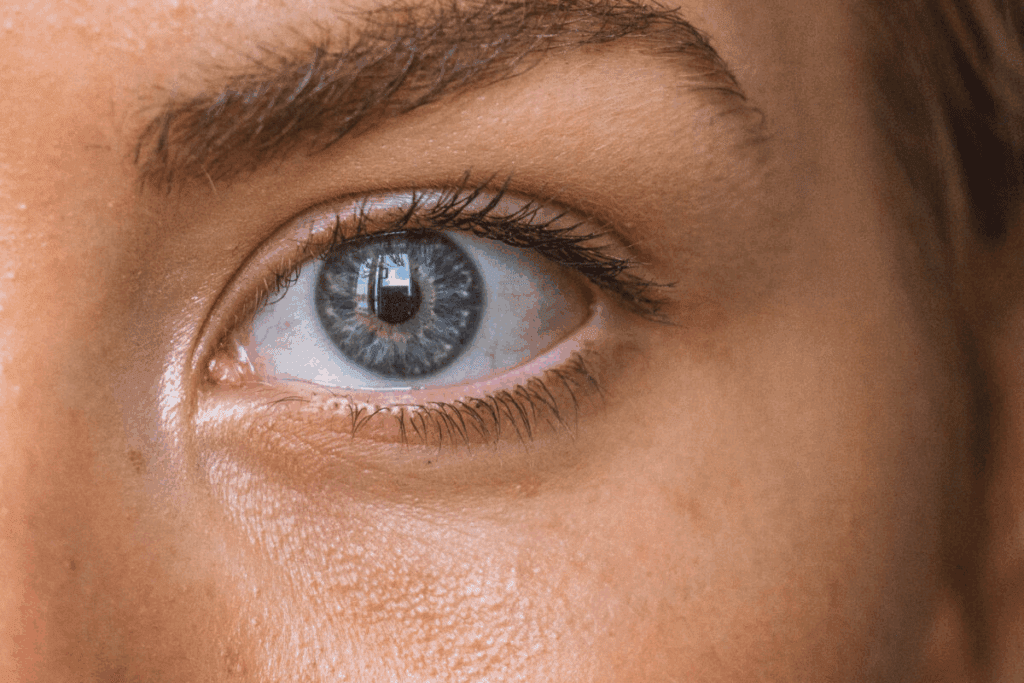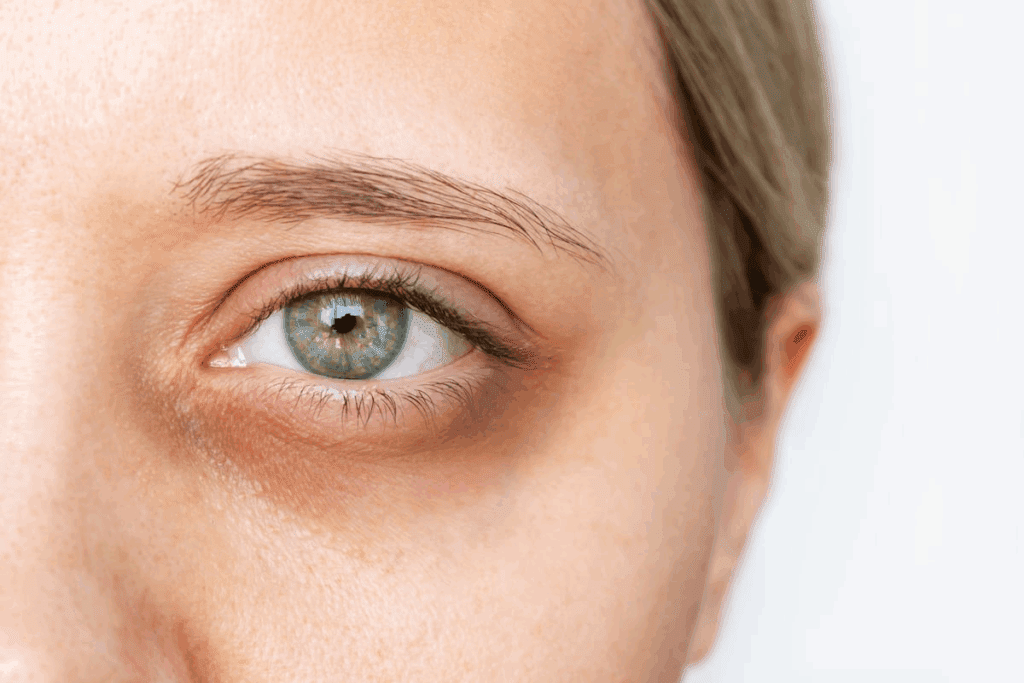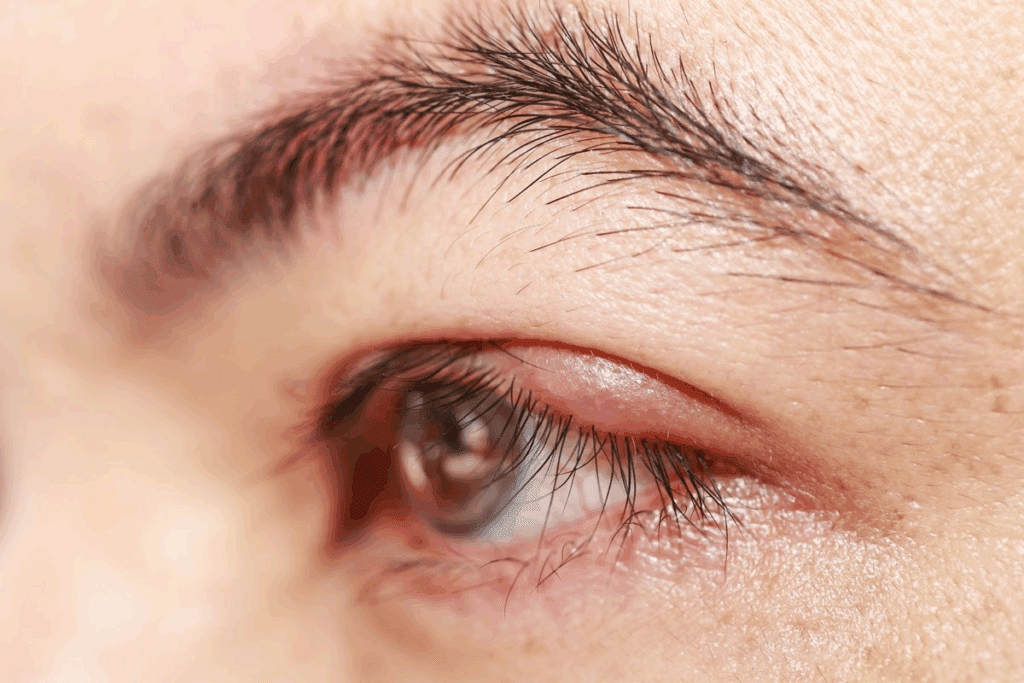Last Updated on November 17, 2025 by Ugurkan Demir

Your eyes can tell a lot about your health. The anemia eyelid test is a simple way to check for iron deficiency and anemia. By gently pulling down the lower eyelid, you can observe the color of the inner mucosa. A healthy person usually has a pink to red color, showing adequate blood and iron levels.
Anemic eyelids, however, look pale because of reduced hemoglobin and fewer red blood cells. This visual change is a key indicator in the anemia eyelid test, suggesting that the body may lack sufficient iron. Recognizing the difference between anemic eyelids vs normal eyelids early can help ensure timely diagnosis and proper treatment.

Our eyelids can show us a lot about our iron levels and blood health. They are not just a shield for our eyes. They also tell us about our internal health, like our iron status.
Eyelids, with their rich blood vessels, can hint at our blood health. The color and state of the conjunctiva, the membrane covering our eyes, can show our iron levels. When iron is enough, the conjunctiva looks pink or red. But if it’s pale or white, it might mean we have low iron or anemia.
Finding iron deficiency early is key. It helps us act fast before it turns into anemia. Anemia is when our hemoglobin is too low. It can cause tiredness, weakness, and a weak immune system. For more on iron deficiency signs,
| Hemoglobin Levels | Health Status | Eyelid Appearance |
| Normal (13g/dl+ for men, 12g/dl+ for women) | Healthy | Pink or red conjunctiva |
| Low (<13g/dl for men, <12g/dl for women) | Anemic | Pale or whitish conjunctiva |
Spotting iron deficiency early can stop bigger health problems. By watching for eyelid color changes, we can keep our health in check.

Learning about eyelid color and its link to hemoglobin can help us understand our health better. Hemoglobin is a protein in red blood cells that carries oxygen. The color of our eyelids shows how much hemoglobin and red blood cells we have.
Hemoglobin makes red blood cells red. When it’s full of oxygen, blood looks bright red. This oxygen-rich blood under our eyelids makes them look pink or red.
But if we have anemia or low iron, our hemoglobin or red blood cells decrease. This means less oxygen in our blood. So, our eyelids might look pale or washed out.
Red blood cells are key to our eyelids looking normal. The conjunctiva, a thin membrane over our eyes, has many tiny blood vessels. When we have enough red blood cells, the conjunctiva looks pink or red.
But if we lack iron or have anemia, the conjunctiva turns pale. This shows we don’t have enough red blood cells or hemoglobin.
The following table summarizes the key differences in eyelid appearance related to hemoglobin levels and red blood cell count:
| Hemoglobin Level | Red Blood Cell Count | Eyelid Appearance |
| Normal | Normal | Pink or red conjunctiva |
| Low | Low | Pale or washed out conjunctiva |
| Normal | Low | May appear pale due to reduced red blood cells |
By knowing how hemoglobin and red blood cells affect eyelid color, we see the value of the eyelid test. It’s a simple way to check our overall health.
Knowing what healthy eyelids look like is key to spotting problems early. Eyelids show how well we’re doing overall, and they look different on everyone. This is because of skin tone and other personal factors.
Healthy eyelids usually look bright red because of good blood flow. This color comes from blood vessels close to the surface. The shade can be light pink or deeper red, depending on health and oxygen levels.
Healthy eyelids have a few important traits:
The look of healthy eyelids changes with skin tone. The tissue color stays the same, but the outer look changes with melanin levels.
For example, darker skin tones might have eyelids that seem more deeply pigmented. But the inner conjunctiva should show a healthy red. On the other hand, lighter skin tones might have more translucent eyelids. This lets the red of blood vessels show more.
Knowing these normal differences helps people check their eyelid health. It lets them spot any issues early.
Low iron levels can change how our eyelids look, making them a sign of anemia. We look for certain signs in our eyelids to see if we have iron deficiency.
The main sign of anemic eyelids is a pale or whitish color of the conjunctiva. This is the membrane covering the white part of our eyes and the inside of our eyelids. Normally, it’s pink because of healthy red blood cells. But if iron levels are low, it might look pale or washed out.
To check, gently pull down your lower eyelid and look at the color of the conjunctiva.
Key characteristics of anemic eyelids include:
Other changes in iron-deficient eyelids include a general pallor or lack of luster. This makes the eyelids look unhealthy or tired. They might also appear slightly swollen or inflamed. These changes can be subtle, so a thorough examination is needed to spot them.
When comparing anemic eyelids vs normal eyelids, the differences are clear. Healthy eyelids are vibrant and pink, while anemic ones are pale and washed out. Spotting these differences is key for early detection of iron deficiency.
Knowing the visual signs of low iron, like pale eyelids and other changes, helps us take action. If you think you or someone else might have anemic eyelids, seeing a healthcare professional is important for diagnosis and treatment.
By gently pulling down the lower eyelid, we can see signs of iron deficiency. This simple test can give us important health insights, like our iron levels.
To do the anemia eyelid test right, follow the proper steps. Gently pull down the lower eyelid to see the inner mucosa. This lets you check the color of the conjunctiva, which shows iron levels.
Step-by-Step Instructions:
The accuracy of the anemia eyelid test depends on the lighting and conditions. Natural daylight is best, but a bright, white light works too.
Optimal Conditions:
Look at the color of the conjunctiva during the test. A healthy conjunctiva is a vibrant red. If it’s pale or whitish, it might mean iron deficiency.
| Observation | Possible Indication |
| Vibrant red color | Normal iron levels |
| Pale or whitish color | Possible iron deficiency |
By following these steps and guidelines, we can effectively use the anemia eyelid test to check for signs of iron deficiency.
Our eyelids can show a lot about our health, like spotting anemia. Knowing the visual signs helps us catch iron deficiency early.
Healthy eyelids are usually a bright red or pink. This is because they have enough hemoglobin. But, anemic eyelids look pale or white because they have less hemoglobin.
Key Color Indicators:
Texture and moisture also show if you might be anemic. Healthy eyelids are smooth and moist. But, anemic eyelids can feel dry or rough because of iron loss.
| Characteristics | Normal Eyelids | Anemic Eyelids |
| Color | Vibrant red/pink | Pale/white |
| Texture | Smooth | Dry/rough |
| Moisture | Well-moisturized | Dry |
Health experts say eyelid condition is a big health clue, including iron levels.
“Iron deficiency can show in many ways, like changes in eyelid look.”
— Health Expert
It’s important to know who is most at risk for iron deficiency. This helps us prevent and treat it better. Iron deficiency is a big problem worldwide, hitting women more than men.
Women of childbearing age lose iron with each period. Pregnancy ups their iron needs even more. This is key for the health of both mom and baby.
The World Health Organization says iron deficiency anemia affects about 30% of women of childbearing age globally. Pregnant women face an even higher risk, showing why iron supplements are so important during pregnancy.
“Iron deficiency is a significant public health problem, specially among women of childbearing age and pregnant women. Ensuring enough iron is key to avoiding bad outcomes.”
Children need iron for growth. Athletes, mainly those in long-distance sports, also face a higher risk. This is because they lose more red blood cells and might have bleeding in their stomachs.
| Population Group | Risk Factors for Iron Deficiency |
| Women of Reproductive Age | Menstrual blood loss, increased iron requirements |
| Pregnant Individuals | Increased iron demand for fetal development |
| Children | Rapid growth and development |
| Athletes | Increased red blood cell turnover, gastrointestinal blood loss |
People with certain stomach problems, like celiac disease or Crohn’s disease, also face a higher risk. Vegetarians and vegans might need to watch their diet more closely to avoid iron deficiency.
Knowing who is at risk helps doctors and health workers focus on prevention and treatment better.
New tech has brought us smartphone apps and digital tools for checking anemia through eyelid exams. These changes are changing how we find and keep track of iron deficiency anemia.
Smartphone apps now check the color of the eyelid’s conjunctiva to spot anemia. A study showed a phone app can check for anemia by snapping a photo of the eyelid. It’s a simple and safe way to check hemoglobin levels.
New digital tools can guess hemoglobin levels without a blood test. They look at the eyelid’s color and other signs to quickly and gently check for anemia. These tools help find and track anemia early, which is great for places with less access to healthcare.
Technology is a big leap in fighting anemia. With digital tools and apps, we can better care for patients. These new ways help people keep an eye on their health and doctors to diagnose and treat anemia better.
Iron deficiency can show up in many ways, not just anemia. There are unusual signs to look out for. We’ll look at five weird signs that might mean you have low iron.
Restless Legs Syndrome (RLS) is a weird sign of iron deficiency. It makes you feel like you must move your legs because they feel uncomfortable. Low iron can cause this. Also, brittle nails can break easily because of iron deficiency.
Here’s a table showing how iron deficiency relates to these symptoms:
| Symptom | Description | Relation to Iron Deficiency |
| Restless Legs Syndrome | Uncontrollable urge to move legs due to discomfort | Low iron levels can contribute to RLS |
| Brittle Nails | Nails become fragile and break easily | Lack of iron affects nail health |
Angular Cheilitis is another sign of iron deficiency. It causes cracks at the mouth corners. It’s painful and uncomfortable. Some people also get Pica, which is craving non-food items like dirt or paper. These signs are less common but important.
Feeling cold in your hands and feet can be a sign of iron deficiency. This is because iron helps with blood flow and keeping your body warm. People with low iron might also find it hard to adjust to temperature changes.
Knowing these signs can help you get help early. If you notice several of these symptoms, see a doctor.
The eyelid test can be helpful but has its limits. It’s good to know these to use it right.
Many things can change how the eyelids look. This might make the test not always accurate. These include:
It’s important to think about these when doing the eyelid test. For example, someone with conjunctivitis might have red, sore eyes. This could hide the pale look of anemia.
| Factor | Effect on Eyelid Appearance |
| Poor Lighting | Can make eyelids appear more pale or red than they actually are |
| Eye Makeup | Can alter the visible color of the eyelids |
| Conjunctivitis | Can cause redness and irritation, masking anemia signs |
If you’re feeling tired, weak, or have trouble breathing, see a doctor. The eyelid test can hint at anemia, but blood tests are the best way to know for sure.
Going to a doctor is key if you’re worried about your health. Blood tests can check your hemoglobin levels and find anemia. This lets doctors give the right treatment.
In short, the eyelid test is helpful but not enough. If you’re worried, see a doctor for a full check-up.
To fight iron deficiency, we need a complete plan. This includes changing what we eat and sometimes getting medical help. We’ll look at how food changes can help, the role of medical treatments, and how to see progress by watching our eyelids.
Eating foods high in iron is key to beating iron deficiency. Red meat, poultry, and seafood are top choices. Beef, turkey, and shrimp are packed with iron. Liver is also a great source.
Leafy greens like spinach and some beans are good too. Here’s a list of foods that can boost your iron:
If diet changes don’t work, we might need medical help. Iron supplements are often given to increase iron levels. Always talk to a doctor to find the right supplement for you.
| Medical Intervention | Description |
| Iron Supplements | Prescribed to boost iron levels |
| Intravenous Iron Therapy | Administered in severe cases where oral supplements are ineffective |
Watching how our eyelids look can show if our iron levels are getting better. As we get more iron, our eyelids should look healthier and more vibrant. Checking our eyelids often can help us see if our treatments are working.
We’ve looked into how the eyelid test helps spot iron deficiency and anemia. It’s easy to do and doesn’t hurt. This test is great for checking iron levels at home.
The test looks at the eyelid’s color and shape, focusing on the conjunctiva. If the conjunctiva looks pale or white, it might mean low iron. This could be a sign of iron deficiency eyelids.
Even though the test isn’t perfect, it’s a good start. If you think you might have iron deficiency, see a doctor for a proper check-up.
Knowing about your eyelid health is key to staying healthy. Watch your eyelids for any odd changes. If you see something different, get it checked by a doctor.
The eyelid test is a simple way to check for iron deficiency and anemia. It looks at the color of the inner eyelid. A healthy eyelid is usually red or pink. But, if it’s pale or whitish, it might mean you have anemia.
Iron deficiency can make your eyelids look pale or washed out. This happens because there’s less hemoglobin. Hemoglobin is what carries oxygen to your tissues.
Healthy eyelids are usually red or pink. This is because they have enough hemoglobin and oxygen. The color might vary slightly based on your skin tone. But, they should look well-oxygenated and smooth.
No, the eyelid test isn’t a sure way to diagnose anemia. It can suggest iron deficiency or anemia. But, a blood test is needed for a confirmed diagnosis.
Women of childbearing age, pregnant people, kids, athletes, and those with certain health conditions are more likely to have iron deficiency.
Yes, there are apps and digital tools. They can analyze the color of the inner eyelid. This helps estimate hemoglobin levels and detect anemia.
Unusual signs include restless legs, brittle nails, and inflammation at the mouth corners. You might also crave non-food items or feel cold in your extremities.
To address iron deficiency, eat more iron-rich foods. For severe cases, supplements might be needed. Watch for improvements in your eyelid color and overall health.
Lighting, observer bias, and certain health conditions can impact the test’s accuracy. It’s important to consider these when interpreting the results.
Yes, as iron levels rise, your eyelids will likely return to their vibrant red or pink color. This shows an increase in hemoglobin and oxygenation.
Subscribe to our e-newsletter to stay informed about the latest innovations in the world of health and exclusive offers!